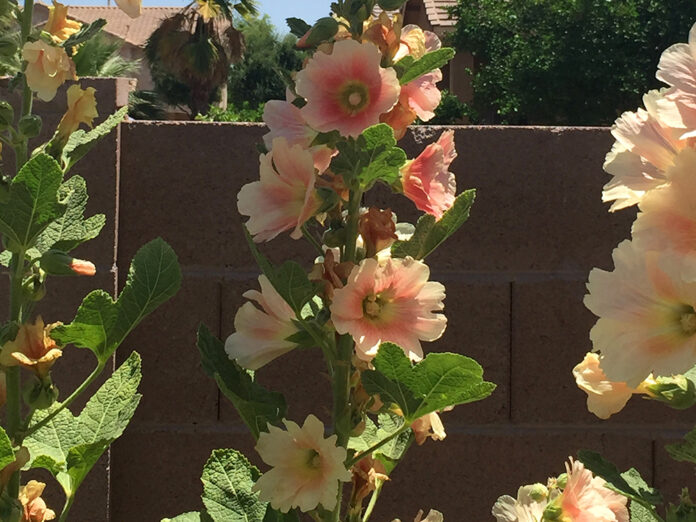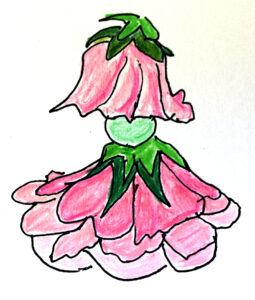
By Alice Batsche
There’s nothing quite like Hollyhocks for an impressive display of color from spring through summer. The plants will grow well in the low desert areas of Arizona as long as they have room to spread.
Hollyhocks, Alcea rosea, belong to the mallow family (Malvaceae) which includes hibiscus, cotton and okra. These flowers lend their beauty to English country gardens and are a romantic addition to our American ones.

The flower symbolizes fertility and fruitfulness, which is evident from its seed basket. Encased in a round husk, the small seeds are arranged in a circle.
Although we don’t detect any fragrance from Hollyhocks, they are loved by bees and hummingbirds. Painted Lady Butterflies use them as their host plant.
Some varieties will bloom the first year if planted in early March, but most are biennials that grow leaves the first year then flowers the second year. By planting seeds in August or September, you will ensure blooms in the spring. The lovely blooms come in all colors, including black.
Simply amazing, they are available as a single flower or a fluffy double one. Halo Blush is a familiar single type, while double-ruffled favorites are Majorette, Chater’s Double and Creme de Cassis.
The flowers grow up the stalk opening more each day. Dwarf varieties, under 3 feet tall, are excellent for borders. Double Dwarf and Fiesta Time are two well-loved ones.
Hollyhocks love full sun and moist, well-drained soil with an acidic to slightly alkaline pH. Most Arizona soils fall into this category at 7.5-8.5 pH but it is helpful to add a small amount of fertilizer in the summer.
To keep them blooming, cut the stalks of the spent flowers at the base of the plant. Removing seed heads will also ensure more blooms. In November, cut the stalks down to six inches and cover with mulch.
These plants have a very large tap root making them difficult to transplant, so keep this in mind when choosing a location. Containers can be used but need to be at least 16 inches deep and two feet wide. Some tall types may need to be staked as they will reach nine feet. Plant them near a wall or fence.
There is a type of rust spores that only preys on hollyhocks. Cut lower leaves if discolored and discard them. It’s important to clear debris from around the stalks and keep water off the leaves.
Enjoy the flower show these old-fashioned plants bring to your garden, and don’t hesitate to grow them in Pinal County.
Alice Batsche is a Master Gardener.






![City gave new manager big low-interest home loan City Manager Ben Bitter speaks during a Chamber of Commerce event at Global Water Resources on April 11, 2024. Bitter discussed the current state of economic development in Maricopa, as well as hinting at lowering property tax rates again. [Monica D. Spencer]](https://www.inmaricopa.com/wp-content/uploads/2024/04/spencer-041124-ben-bitter-chamber-property-taxes-web-218x150.jpg)

![3 things to know about the new city budget Vice Mayor Amber Liermann and Councilmember Eric Goettl review parts of the city's 2024 operational budget with Mayor Nancy Smith on April 24, 2024. [Monica D. Spencer]](https://www.inmaricopa.com/wp-content/uploads/2024/04/spencer-042424-preliminary-budget-meeting-web-218x150.jpg)



![Alleged car thief released without charges Phoenix police stop a stolen vehicle on April 20, 2024. [Facebook]](https://www.inmaricopa.com/wp-content/uploads/2024/04/IMG_5040-218x150.jpg)




